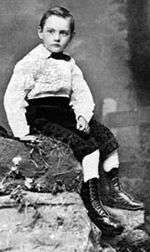Leland Stanford Jr.
Leland Stanford Jr. (May 14, 1868 – March 13, 1884), known as Leland DeWitt Stanford until age nine,[1] is the namesake of Stanford University, adjacent to Palo Alto, California, United States.
Leland Stanford Jr. | |
|---|---|
 Leland Stanford in 1872 | |
| Born | Leland DeWitt Stanford May 14, 1868 Sacramento, California, U.S. |
| Died | March 13, 1884 (aged 15) Florence, Italy |
| Nationality | American |
| Known for | Namesake of Stanford University |
| Parent(s) | |
Early life
He was the only child of Governor of California Leland Stanford and his wife Jane Stanford (née Lathrop). His mother was 39 years old when he was born, after 18 years of childless marriage to Leland Stanford.
Illness and death
Leland caught typhoid two months before his 16th birthday, while on a Grand Tour of Europe with his parents. He originally fell ill in Athens. His parents rushed him to Italy for medical treatment, first to Naples, then to Rome, and eventually to Florence, where he died after weeks of alternately improving and worsening condition.[2]
Stanford University
Leland Stanford Sr. told his wife that "the children of California shall be our children."[3][4][5] To honor their son upon returning to the United States, the Stanfords devoted their fortune to a memorial in his name: Leland Stanford Junior University. The university opened its doors in 1891.
Leland Stanford Jr. is interred beside his parents at the Stanford family mausoleum on the Stanford campus. After the death of his father on June 21, 1893, his mother guided the development of the university until her murder on February 28, 1905.
Nomenclature
Although the university is generally referred to as "Stanford University" or "Stanford", its official name is still "Leland Stanford Junior University", as seen on the university seal.[6]
References
- Stanford Founders
- Mirielees, Edith R., Stanford:The Story of a University, G.P. Putnam's Sons, New York, 1959, p. 20
- The National Cyclopaedia of American Biography, Vol. II, p. 129. New York: James T. White & Company, 1899. Reprint of 1891 edition.
- Dictionary of American Biography, Vol. XVII, p. 504. New York: Charles Scribner's Sons, 1935.
- Cleveland Amory, Who Killed Society?, pp. 432–433. New York: Harper & Brothers, 1960.
- Viz.